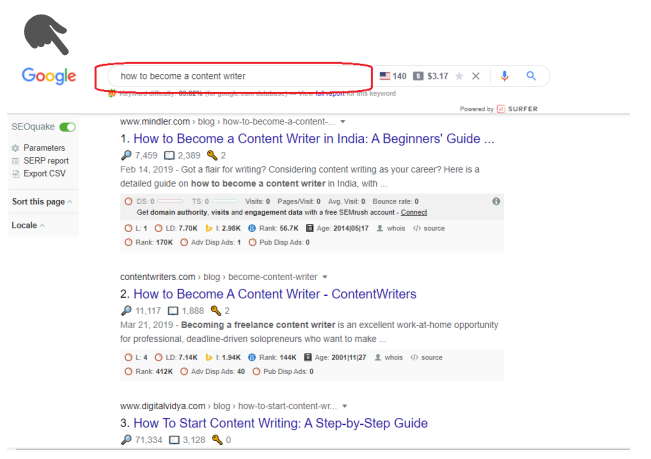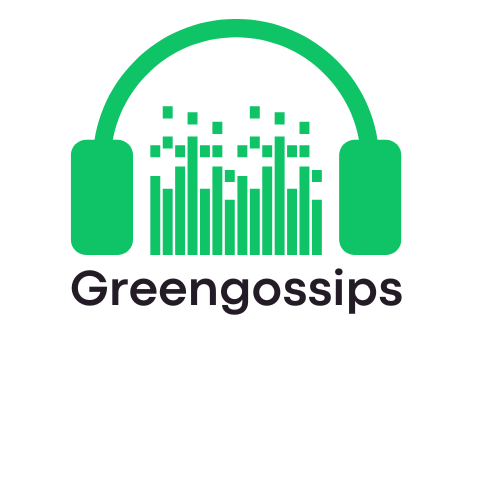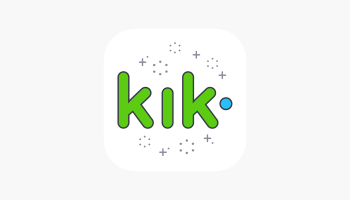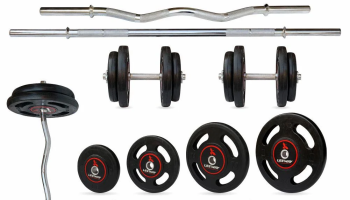There are several types of content available to enrich your website. The most popular types of web content are Blog Posts, Articles, Infographics, Online Surveys, GIFs, Slide Shows, E-Books, Templates, Images, and Videos. Each of these contents has a certain type of structure.
In particular, we are here to show you how to construct a blog post and web articles. We are about to share every single aspect of writing a blog post. What to write, why to write, and how to write.
First, let’s view the blog post or article content quickly.

What is a Blog Post/Article?
You are looking for something. A solution to your problem, or a piece of information to enhance your knowledge, or maybe something entertaining.
When you look on the internet for what you desire, type something on Google, and Hit the Enter key. What do you see? Many websites provide you information you are looking for.
For example, you typed “How to become a content writer” in Google. You see something like this.

As you can see, there are various websites ranked in the search results with their unique contents. These contents are blog posts, or you can say article content. Blog posts are shorter than the articles, word count ranging from 700 – 1200. Articles consist of 1000 – 2500 words.
Both types of web content are created to feed information on a certain topic. In this case, the information is on how to become a content writer. Now, as you wish to be a content writer, you must know the basic structure of content writing.
Let’s break it down.
The Basic Structure of Content Writing
The primary elements to construct blog content are – the Title, Intro, Content Body, & Conclusion. When you stumble upon a blog post, what do you see?
You see a Title and the content body. Now the content body comes with an Introduction, Main body, and Conclusion.
As shown in the image below –

The first portion of the content comes with the Title, followed by the Introduction, Body, and Conclusion. Looking at the image, you have now a brief idea of content structures. Each of the content parts has its importance. Let’s see their importance and how to create them.
Importance of Different Aspects of Blog Posts – How to Create Them
Every aspect of a blog post is important. Starting with the importance of the Content Title, will be discussing them all.
Title: Why & How to Create Them
Your blog Title appears everywhere, but not the entire content.
It’s a great thing to write an excellent blog post with perfect on-page SEO. But adding an attractive title to a blog is a definite, YES.
A title determines the selling point of any blog. And this is determined even before readers scroll down to the content looking for what they need.
A title reflects the content of a blog as a whole. Wherever you share the blog post, be it on a social media platform, through email, or any other way, a well-established title can be a good start to excellent exposure.
The title is also used as clickbait by many content creators knowing the fact that it’s the first thing a reader sees.
Put on the shoes of a reader, would you click on every single blog post? No!
Consciously or subconsciously, you click on a content link only when the Title attracts
you.
The title is Important for SEO!
The title influences overall SEO as well. A good title gets you more organic traffic, ultimately improving your search engine rank. It has a lot to do with on-page SEO. Apart from keeping an attractive title, you should also look after the SEO aspect.
A keyword is the term people type in the search engines. The better the search volume of a keyword, the higher the chances of getting more web visitors.
You can insert keywords into the title to make the visitor and the Search Engine understand what’s the content about.
Keeping the title short but self-explanatory is an important part of an excellent Search Engine Optimization procedure.
Here are the key points to mind while writing a great blog title –
- Set the right expectations.
- Make it short and sweet.
- Make it engaging.
- Include one or two keywords but don’t do it too much.
Introduction: Holds the Key to Keep Visitors Hooked
No matter how captivating your blog TITLE is, it’s the Intro that will turn your
visitors into readers.
Your audience does not know yet whether your content has the solution or information they need. They cannot trust your blog in the first impression by Title alone. They are looking for more clues to believe that you have something to offer before reading the entire blog.
No one is reading your entire blog post only to regret of wasting time. The best way to make up their mind is skimming over the Intro looking for a quick overview of your blog.
You can feel how important your Introduction is.
Now, how are you supposed to convince and convert your visitors to readers?
Keeping an introduction short yet engaging is the best way to keep a reader hooked. As a writer, don’t get too carried away talking about stuff that isn’t related to the topic of your content.
Nor should one keep the intro too short so that readers won’t find it vague. The key point is to talk about the basics of your content providing a brief idea of what’s inside
Alright, you have learned that your blog Introduction should be short and informative enough. That so far is a theory. What about applying the idea practically?
These working tips will help you craft a better blog Introduction as you go –
- Invite your reader citing their concerns about the way have been through the same situation.
- Say something that you have in common with the readers to create an instant bond.
- Tell your own story – addressing the readers as your friend.
- Create mystery in the intro with a promise to unfold it in the main content body.
- Use quotes by well-known authors to make the intro interesting.
- State facts or sources with exact numbers – make sure they are reliable.
The Body: All the Required Information Lies Within
A well-organized Content Body is like the building block of a perfect blog post. When a writer talks about a particular topic, it’s important to keep everything well-structured.
Most of the readers tend to scroll down once through a post searching for whether that particular post is worth their time. The importance of well-structured blog post is important for many reasons. That includes making a catchy content body.
When it comes to online readers’ behavior, even after being convinced by your great intro, they are looking for a clean and simple content body. They want to read something that doesn’t put much pressure on their eyesight as well as on their mind.
Big paragraphs are big No!
The content body’s primary role is to provide the readers a complete information on a certain topic. In the meantime, the body must be packed with great readability.
Readability matters, big time!
Putting up a better readability to your blog post requires the following factors –
- Using a conversational tone, use words like “I”, “You”, and “We”.
- Keep your paragraphs and sentences short and informative.
- Use formatting tags like Bold, Italic, and Underlines, for specific vital words or
- phrases.
- Use strong adjectives instead of weak ones; e.g. It’s freezing (I̶t̶’̶s̶̶v̶e̶r̶y̶̶c̶o̶l̶d̶), Great
- (V̶e̶r̶y̶̶g̶o̶o̶d̶), etc.
- Use headings and subheadings properly.
- Use the bulletin points and numbering to enlist important points.
- Use relevant and royalty-free images as needed.
Headings and Subheadings are important parts of well-written blog content. Using the heading right will help execute the steps you want to initiate to explain the topic better.
Heading and subheadings are separated in numerical order respectively.
- Subheading 1
- Subheading 2
- Subheading 3
- Subheading 4
Conclusion: Ending Your Blog Post isn’t the End
The basic concept of the Conclusion is to end your blog post. But’s that not the end yet. I will tell you why. I’m sharing my ‘mistakes as a beginner’ first.
Initially when I began as a content writer – Title, Intro, and Body were my prime concerns.
I worked hard for a catchy headline, a clever hook, and an informative body.
My concept was, “I have given all the information already, why spend too much effort on a conclusion?”
It was a mistake which I don’t want anyone else would do. Why?
Why the Conclusion is so important?
It is important to keep a blog engaging, right from the moment when a content idea pops up in your head – til the end of the post. Throughout the entire write-up, the writer needs to connect with the readers.
Engaging directly with your readers, convincing them to follow your blog, and making them thrive for more – results building your authority. And, the conclusion plays a vital role in building your blog authority.
A convincing ending leaves an immense impression on your readers and leaves them wanting to engage on your other blogs and social media profiles as well. This is the point, you can turn a reader into your follower.
Being a blog writer, the first impressions aren’t just what you need to keep in mind. It is equally important to end the post with a friendly yet professional note. Maintain a good relationship with your new readers – keep them hooked with the latest post.
Writing a great Conclusion? – These tips will impact the most.
The Conclusion is about building relationships with your readers – getting followers.
Here’s how you do it –
- Summarize and restate the key points and tell them why it’s important
- Leave a question and encourage the readers to comment.
- Ask your readers to share the post with people looking for a solution.
- Leave a challenge where it fits.
- Ask your visitors where they want you to serve better or make an improvement.
- And, add a focus keyword for SEO.
Blog Structure – It’s a Bridge Connecting Your Blog with Audience & Search Engine
The main idea of constructing blog content with many structures is to make it user-friendly as well as search-engine-friendly. It’s about making your blog visually appealing and easy to read for your readers. Also, about crafting your blog the way search engines can understand it has the information a visitor needs
Once you understand this basic idea, it will help you come up even with better creativity for constructing a blog article.
Remember, every single element such as Title, Intro, Body, and Conclusion has its own important role to play.







